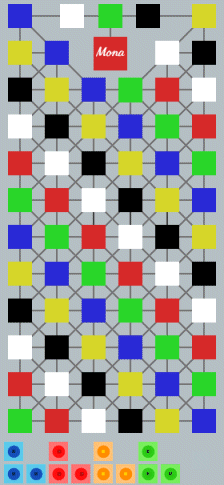

Mona is played with a six-sided die with different colours on each side. A piece must go to a same colour square as the die colour. If no square of that colour is available, the move is passed. If the square is occupied by an enemy piece, it is captured and immediately returned home, from where it must begin anew. It is not allowed to capture a piece if a non-capturing move is also available. All three pieces must leave the home base before they can start moving on the board.
Each player casts the die three times in a row, and moves any of his pieces after each cast, but only one square at a time. The game is won if a piece reaches the large red square. Backwards movement is not allowed (except when reaching the goal).
Mona (The Bird Game) was invented by the Danish mathematics teacher Sophus Tromholt and was published by Otto Maier, Ravensburg, in 1892. It was reintroduced in 1930. Mona is decided almost exclusively by the luck of the die throw. It is less difficult to master than Ludo. Nevertheless, it’s entertaining.
Reference
Mona rules sheet (German) (here)

A Mona game from 1892 (K. Moss).
A thanks to P. Michaelsen for providing information about this board game.
☛ You can download my free Mona program here, but you must own the software Zillions of Games to be able to run it (I recommend the download version).
© M. Winther, 2019 December